03 About the Inquiry He kōrero mō te Uiui
Why and how the Inquiry was established
The Government announced the establishment of the Royal Commission of Inquiry into COVID-19 Lessons Learned I Te Tira Ārai Urutā on 5 December 2022. The announcement came not long after the public health measures – mask wearing, vaccine mandates, isolation requirements and more – had been retired. Likewise, the extraordinary powers that the Government was able to exercise under legislation throughout the pandemic had been largely wound back.
Even though the SARS-CoV-2 virus was still very much a part of daily life, Cabinet considered the time was right ‘to invest in a process to learn from Aotearoa New Zealand’s COVID-19 experience and to use those lessons to strengthen New Zealand’s preparedness for any future pandemics’. Ministers decided it was fitting for this task to be undertaken by a Royal Commission – the highest form of public inquiry – given the magnitude of the COVID-19 emergency, the scale and complexity of its impacts, and the toll it had taken on the country’s social and economic wellbeing.4
The then-Prime Minister Jacinda Ardern confirmed that epidemiologist and public health medicine specialist Professor Tony Blakely would lead the Royal Commission. He would be joined by two members, former Cabinet Minister, the Honourable Hekia Parata (Ngati Porou, Ngāi Tahu) and former Treasury Secretary John Whitehead CNZM KStJ. All three were subject matter experts who brought a ‘unique set of skills’ to the Inquiry, the Prime Minister said.
They would be supported by a secretariat, with the Department of Internal Affairs serving as the host agency. The Inquiry would start hearing evidence from February 2023 and deliver its report by mid-2024 (later extended to the end of November 2024).
Following the 2023 election, the new Government signalled it was considering changes to the Inquiry’s terms of reference. After a public consultation process, it announced in June 2024 that a second inquiry phase would begin when Phase One ended. It would have different terms of reference and new commissioners. Grant Illingworth KC was appointed as a commissioner, and later appointed chair of Phase Two, alongside fellow commissioners Judy Kavanagh and Anthony Hill. The Phase Two report is scheduled to be submitted by 26 February 2026.
Our terms of reference
Our terms of reference5 set the parameters for both the scope and style of the Phase One Inquiry. They confirmed our core task: to look at how to strengthen Aotearoa New Zealand’s preparedness for future pandemics. We were asked to give effect to this by identifying what lessons could be learned from New Zealand’s response to COVID-19 between February 2020 and October 2022, and how those lessons could be applied in preparation for any future pandemic.
Specifically, we were asked to consider:
- The public health response and the delivery of health services – including things like border closures and MIQ arrangements; the approval and mandating of vaccines; lockdowns and isolation arrangements; as well as modelling and surveillance systems, vaccine passes, gathering limits and PPE, along with continued delivery of necessary health services.
- The provision of goods and services – such as how people’s everyday needs were met during the pandemic; the provision of lifeline utilities and services (water, electricity and so on); how education and childcare services were delivered, along with other essential services that the Government provides, like regular superannuation payments or housing.
- The economic response – the support available to individuals and businesses (such as the wage subsidy); the exemptions that were put in place for specific industries (farming, for example); and the Government’s economic response more generally.
- Government decision-making, communication and engagement – what decision-making structures and arrangements were used to manage and deliver the response? How did people and communities receive information and how did Government engage with them, in order to limit the spread of the virus and ensure everyone was kept safe?
Our terms of reference were therefore broad. Across health, economic and social aspects of the country’s response, the Inquiry was asked to examine the legislative, policy and operational settings applying throughout the response and to consider: what can be learned that could improve Aotearoa New Zealand’s preparedness and response to a future pandemic? The terms of reference also required us to examine how the pandemic response addressed the interests of Māori, consistent with the te Tiriti o Waitangi relationship, and any disproportionate impacts the pandemic may have had on particular population groups and communities. We were also invited to assess the effectiveness of the various pandemic strategies, settings and measures (both health and economic) that were adopted.
Our terms of reference exclude certain aspects of the pandemic response. Out of scope matters included specific clinical decisions, the wider health system reforms, decisions of the courts and oversight bodies, the private sector’s operations (beyond delivering essential services), particular decisions taken by the Reserve Bank of New Zealand’s independent monetary policy committee during the COVID-19 pandemic, adaptation of court procedures and parliamentary processes, and the conduct of the general election. In addition, ‘the specific epidemiology of the COVID-19 virus and its variants’ and ‘vaccine efficacy’ were out of scope. As regards the first exclusion, an analysis of matters such as the detailed structure, immunology and cellular interaction of the SARS-CoV-2 virus is out-of-scope; but widely understood and elementary points like the increasing infectivity and changes in virulence of variants (such as the Delta and Omicron variants) are not excluded from our consideration. Similarly, in medical usage there is a well-established distinction between ‘efficacy’ and ‘effectiveness.’ Simply put, an assessment of efficacy would involve a systematic review, in deep detail, of a vaccine’s ability to provide protection against a virus (and its variants), with laboratory studies and clinical trials (including immunological and specific vaccine safety, side effects and adverse effects). An evaluation of that kind is obviously out-of-scope for present purposes. However, the more general concept of vaccine ‘effectiveness’ is qualitatively different. It includes, for example, how well the Pfizer vaccine performed in reducing transmission and protecting against serious illness and death in Aotearoa New Zealand. We have obviously had to consider issues of that kind as they underpin the rationale for an elimination strategy, the pace at which a country opens up as vaccine coverage increases, and the deployment of vaccine requirements such as mandates, employer vaccine policies and vaccine passes.
The terms of reference emphasise that the Phase One Inquiry’s aim is to extract lessons for the future. We should not take a legalistic and adversarial approach (see ‘Our approach to the Inquiry’) and should use the least formal information-gathering processes possible. We were required to utilise publicly-available information as much as possible and seek any additional information we needed in an efficient and targeted way.
Our approach to the Inquiry
| Throughout Phase One, our approach has been: | |
|---|---|
|
Non-adversarial:
|
Under the Inquiries Act 2013, a Royal Commission must conduct its inquiry in accordance with that Act and the terms of reference, but otherwise as it considers appropriate. Our terms of reference directed us to use a non-adversarial approach. |
|
Scenario-focused:
|
Our work has been informed by scenario thinking – a way of understanding and planning for future events when, like pandemics, we do not know what ‘type’ they will be nor when they will occur. The next pandemic could play out in many ways, depending on the specific pandemic agent involved (such as a virus), the response measures adopted, and the social, economic and political context in which it occurs. However, using scenarios, we can still determine and plan for the most likely types of pandemics that will occur and the likely range of economic and social impacts; we are not powerless. Our lessons and recommendations seek to strengthen Aotearoa New Zealand’s readiness to meet a range of future pandemic scenarios. They also urge those tasked with preparing for and delivering future pandemic responses to ensure scenario thinking – supported by modelling – is at the heart of those preparations. For more on scenario thinking and its application to pandemic policy and investment decisions, see Appendix C. |
|
Exploratory, holistic and forward-looking:
|
Rather than undertaking an overly forensic analysis of past activities and decisions, we inquired into the areas identified in the terms of reference from a broad and holistic perspective, looking for common issues and themes in the pandemic response. We focused on inquiring deeply enough to extract lessons, but the breadth of our terms of reference meant we did not need to dig exhaustively into every last detail of what happened. This allowed us to develop lessons and recommendations that span several areas, are sustainable and flexible, and can have real system-level impact in the next pandemic, whatever its cause, trajectory and duration. |
|
Non-duplicative:
|
As required by our terms of reference, we have not sought to duplicate the already existing extensive analysis of Aotearoa New Zealand’s response to COVID-19 and the lessons arising already undertaken by others (see ‘Existing reviews’). We have certainly taken account of this valuable work, but much of it is specific to COVID-19 or addresses only particular aspects of the response. Our approach has been broader and explicitly focused on a range of possible future pandemics. Consistent with our remit – and our public feedback process – we have indeed ‘looked back’ on the COVID-19 experience. But we have done so with the express aim of learning how New Zealand can prepare itself to ‘move forward’ with more confidence in either similar, or potentially somewhat different, circumstances. |
Finally, we want to clarify the relationship between this Phase One report and Phase Two of the Inquiry. This report is the result of work planned and undertaken independently of the terms of reference governing Phase Two. We were guided by the original terms of reference, and had in fact completed our evidence-gathering and begun drafting this report when Phase Two was established.
We consider that the breadth of the work carried out in this initial phase and presented in this report prepares the ground for, and will complement, the next phase of the Inquiry. Phase Two will look deeper into some of the same areas and also address the issue of vaccine safety and harm, excluded from the scope of Phase One.
How we gathered and used evidence
As our remit was to inquire into many dimensions of Aotearoa New Zealand’s response to COVID-19 – public health, economic and social – our evidence base has been necessarily wide-ranging. We have considered information from many sources, including:
- investigations, reports, reviews and research (both domestic and international) and other publicly available information – including Cabinet papers, and minutes of advisory groups and oversight bodies proactively released by government agencies;
- written evidence provided by government departments and other parties;
- additional evidence requested by the Inquiry;
- public submissions; and
- evidence gathered via direct engagements with key stakeholders, decision-makers, public servants, independent experts, and communities most impacted by the pandemic. These engagements took the form of face-to-face or virtual meetings, interviews and correspondence.
Evidence snapshot
Phase One of the Inquiry received evidence and information from across the length and breadth of Aotearoa New Zealand.
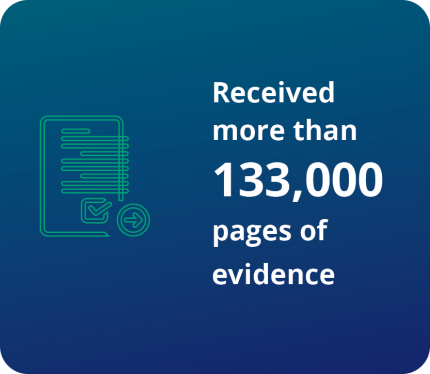
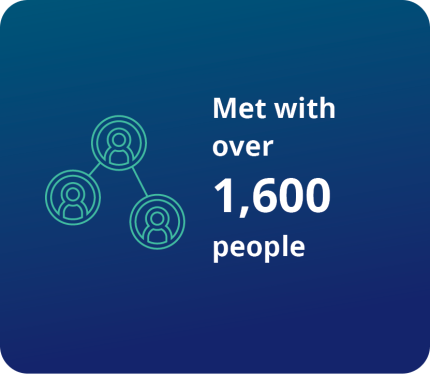
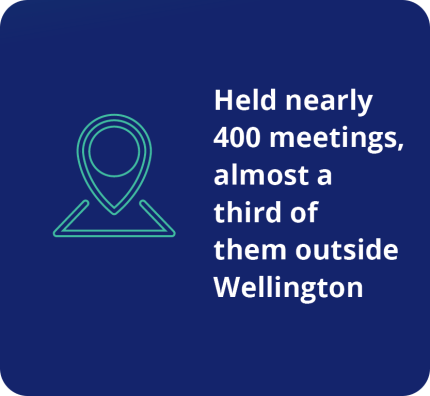
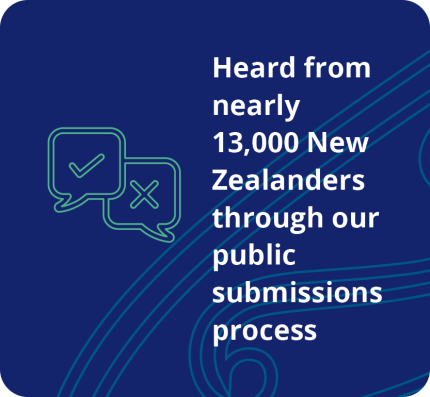
The views, suggestions and evidence provided by these people and groups have been incorporated into our assessment of the overall COVID-19 response and helped us to identify key lessons for the future.
Existing pandemic reviews (domestic and international)
As noted above, the terms of reference asked us to consider existing investigations, reports and reviews relating to the COVID-19 response although we were to avoid repeating work already undertaken and were free to reach different conclusions. Seventy-five reviews of the domestic response had been produced since 2020, generating 1,639 recommendations.
The Cabinet paper ‘Establishing an inquiry into New Zealand’s preparedness for a future pandemic’ (October 2022) summarised the 37 domestic reviews most relevant to our work.6 They included rapid reviews of the initial all-of-government operating model and governance arrangements, material produced by the COVID-19 Independent Review and Improvement Advice Group, the Office of the Auditor-General’s report into all-of-government coordination in the first year of the response, reviews of COVID-19 clusters in aged-care facilities, a report on the implementation of the Covid-19 Surveillance Plan and Testing Strategy, and inquiries into the MIQ booking system, isolation facilities and prisons.
Starting from this list and supplementing it with other reviews and analysis we identified, we amassed a comprehensive record of findings and data about the Aotearoa New Zealand pandemic response. The existing reviews inform the analysis, lessons and recommendations set out in this report, and are referenced throughout. However, many of these reviews focused on specific topics, usually operational, and a particular point in time.
While they certainly offered useful insights about particular pandemic phases, their specificity and limited parameters meant we sometimes needed to seek out more information and perspectives that shed light on their findings. None had sought to provide a comprehensive, holistic, future-oriented picture of the entire pandemic response, nor considered what lessons might apply for future pandemics that are different from COVID-19.
Similarly, we reviewed the considerable body of literature and evidence on the international COVID-19 experience. It encompassed formal inquiries, like ours,into other countries’ responses, and assessments by independent and international bodies. Those which have been particularly helpful to our work include:
- UK Covid-19 Inquiry – Resilience and preparedness (Module 1)7
- Commonwealth Government of Australia COVID-19 Response Inquiry8
- Fault Lines: an independent review into Australia’s response to COVID-199
- Australian Government Crisis Management Framework10
- Dutch Safety Board, Investigations into the Approach to COVID-19 crisis11
- OECD Policy Responses to Coronavirus (COVID-19)12
- Fiscal Monitor Database of Country Fiscal Measures in Response to the COVID-19 Pandemic13
- Independent Panel for Pandemic Preparedness and Response, co-chaired by Her Excellency Ellen Johnson Sirleaf and the Right Honourable Helen Clark.14
Direct engagements
The Phase One terms of reference did not direct us to undertake public hearings. However, we wanted to engage authentically with a wide range of groups and individuals in order to fully understand the complex and multi-faceted impact of the pandemic, and to inform our lessons. For example, when considering how the next pandemic response could best support the wellbeing of essential workers (such as people working in supermarkets or at the border) or communities and population groups likely to be especially impacted (Māori and Pacific peoples, for example), we knew that those were the people we needed to talk to.
Starting in June 2023, we undertook an extensive programme of targeted, in-person (and sometimes virtual) engagements – interviews, hui and facilitated group meetings. Over the next 15 months, the people and groups we met with included:ii
- those who implemented the response (including representatives of government agencies, the private sector, non-governmental organisations, community groups, charities and not-for-profit groups, and more)
- key government decision-makers
- the public service leaders and officials advising them
- iwi and Māori organisations (who in many cases also led the pandemic response in their own communities)
- representatives of the health, education, and business sectors
- individual business owners
- researchers and experts in a wide range of disciplines
- members of the disabled community
- members of the Pacific and other ethnic communities
- representatives of numerous stakeholder groups – peak bodies for specific sectors and professions; media and communications; local authorities; faith groups and more.
- advocacy groups representing a wide range of viewpoints, including those sceptical of, or opposed to, aspects of the pandemic response.
- people and groups who were not involved in delivering the response but were willing to share how it had affected them. We were particularly keen to meet with those whose voices went largely unheard in the pandemic so we could better understand the human impact of COVID-19 policies, legislation, regulations and public health measures.
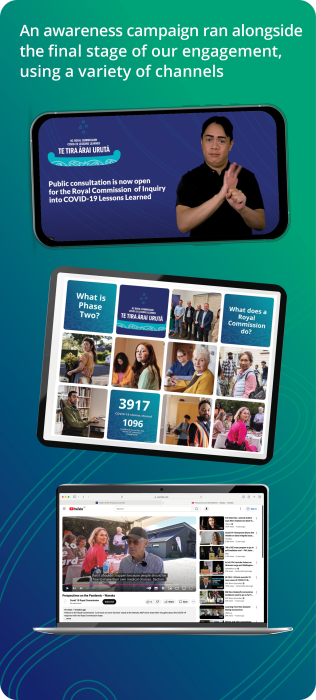
Public input
The final stage of our engagement approach was to call for public input through an online submissions process. An awareness campaign ran alongside it, using a variety of channels. As part of the campaign, we had a presence at various public-facing events ranging from community markets and A&P (agricultural and pastoral) shows to music festivals. This was an excellent opportunity to talk informally about COVID-19 and what could be learned from it with people holding a wide range of viewpoints – and to encourage or support them to make a submission.
We also worked with partners to connect with ‘hard to reach’ communities and individuals who might not otherwise have engaged with us. Where appropriate, we employed a trauma-informed approach, recognising that for some people – such as those who experienced the death of a loved one – the effects of the pandemic were significant and continue to be felt deeply.
Confidentiality arrangements
Our engagements were held in private. Everyone taking part was assured that any notes or recordings made by Commissioners or staff from the Secretariat would remain confidential until the end of the Inquiry (at which point the provisions of our fourth procedural minute, which sets out the Inquiry’s final non-publication orders, would apply).
These arrangements were consistent with our general approach to the confidentiality of all non-public evidence gathered during the Inquiry – whether through direct engagements, in written evidence or through the public submissions process. In all cases, we wanted to encourage discussion and evidence that was rich, free and frank, and given without fear of repercussions. Preserving confidentiality would also allow us to ascertain all the facts necessary to support robust lessons and recommendations.
| We issued three procedural Minutes confirming our approach: | ||
|---|---|---|
On 2 June 2023, we put in place an interim order forbidding the publication of all evidence and submissions provided to the Inquiry until further orders were made. The Minute also specified that there would be no public access to Inquiry meetings or to correspondence relating to information requests. |
First issued on 17 July 2023 and re-issued on 27 September 2023, this Minute gave guidance on who could attend engagements, how the Inquiry would look after and use the information provided to us, how people’s views would be attributed in the final report, and the natural justice processes that would be undertaken (discussed further in the Conclusion).iii |
On 6 December 2023, the Inquiry’s third procedural minute addressed how information received through the public submission process would be treated. Where confidentiality was requested, it was granted. |
Of course, maintaining confidentiality has not prevented this report from referring to the information we gathered and drawing conclusions, lessons and recommendations from it. But it does mean much of the evidence that informs our analysis has not been formally cited, unless we sought and received permission from the source to quote from or otherwise identify their evidence. Likewise, statements or views are not attributed to specific organisations or individuals except with their agreement. Publicly-available sources are cited.
The analytical process
The lessons and recommendations set out in this report are founded in a thorough and careful analysis of the information and evidence relevant to our terms of reference.
We began by examining each topic within the Inquiry’s scope – identifying the relevant legislative, regulatory and operational settings and then analysing the relevant evidence through a series of research questions. We applied a consistent analytical framework across the various matters under inquiry and considered cross-cutting issues, including ethical and human rights perspectives, cost-effectiveness, optimal policy-making and implementation arrangements, te Tiriti and equity. This approach allowed us to manage the breadth of the terms of reference, to undertake a thematic analysis that approached the topics for inquiry in an integrated way, and to avoid ‘siloed’ assessments.
On the basis of this analytical work, we identified lessons about Aotearoa New Zealand’s COVID-19 response – namely, whether it was effective in limiting both the spread of infection and the impact of the virus on vulnerable groups and the health system. These lessons from looking back at the pandemic, and the analysis supporting them, are set out in the ‘Looking Back’ chapters of this report (Part 2).
We then turned our attention to the future, using the most actionable insights arising from what we learned looking back to develop lessons for the future. We then developed a suite of recommendations giving practical effect to the lessons. Our lessons and recommendations are presented in the ‘Moving Forward’ chapters (Part 3).
This approach allowed us to manage the breadth of the terms of reference, to undertake a thematic analysis that approached the topics for inquiry in an integrated way, and to avoid ‘siloed’ assessments.
Conclusion
We are confident in the robustness of our evidence-gathering and analytical processes. We cast a wide net, looked closely at international pandemic experiences and outcomes as well as Aotearoa New Zealand’s, encouraged candid conversations, and deliberately sought out a diversity of views and pandemic experiences – including from people and groups who remained ‘below the radar’ during the pandemic or are considered hard to reach.
Supported by the Secretariat, we have weighed, assessed and cross-checked the evidence. We ensured we tested our assumptions, and we took account of a range of scenarios and counter-factuals. We requested those whose evidence was relied on to check the accuracy of parts of our report. We were mindful of the need to ensure that, in accordance with the Inquiries Act 2013, we undertook a fair process and gave those who were referred to in the report – or against whom we proposed to make an unfavourable finding or statement – were given the opportunity to review those statements. We carefully considered all responses received and changes were made to the draft report as appropriate.
As a result, we consider our lessons and recommendations are soundly based. We trust they will help ensure Aotearoa New Zealand is well-prepared to respond to a future pandemic.
ii A complete list is available at https://www.covid19lessons.royalcommission.nz/the-inquiry/record-of-inquiry-engagements.
iii The Inquiries Act 2013 requires us to ensure that if the Inquiry makes a finding that is adverse to any person, that person is aware of the matters on which the finding is based and has had the opportunity to respond before our report is finalised.


